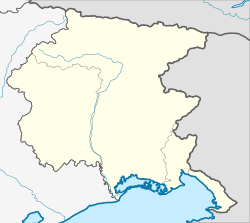|
Polcenigo
Polcenigo (Friulian: Polcenic, locally Al Borc) is a comune (municipality) in the Regional decentralization entity of Pordenone in the Italian region Friuli-Venezia Giulia, located about 110 kilometres (68 miles) northwest of Trieste, 95 kilometres (59 mi) north of Venice and about 14 kilometres (9 mi) northwest of Pordenone. Located on the slopes of the Western Carnic Prealps, in a quiet region surrounded by a charming landscape, it is a renowned water springs area characterized by numerous small streams, torrents, lake-like springs all flowing into river Livenza, whose waters springs in the place called Santissima. Polcenigo borders the following municipalities: Budoia, Caneva, Fontanafredda, Tambre. It is one of I Borghi più belli d'Italia ("The most beautiful villages of Italy").[3] HistoryRemains of prehistoric stilt houses, from the 4th millennium BCE, were found in the Palu' area, close to Livenza's springs, which is part of the Prehistoric pile dwellings around the Alps UNESCO World Heritage Site.[4] Afterwards, around the 1st millennium BCE, the Adriatic Veneti settled in the area, leaving bronze archaeological remains. In San Floriano hill, archaeologist have found an ancient Roman necropolis dating from the 5th or 4th century BC. Other sights include the castle and the Museum of Gastronomy Culture. LandmarksReligious buildings
Secular buildings
Archaeological site and natural area
Museums
References
External linksWikimedia Commons has media related to Polcenigo.
|
||||||||||||||||||||||||||||||||||||||||||||||||||




